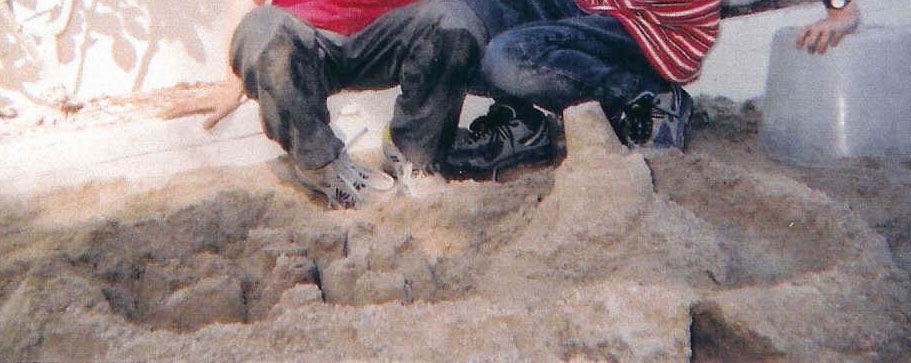|
44
School
Days and Preschool Days, Too:
A treasury of anecdotes culled from my work
and play as a preschool worker and an elementary school after- school
activities supervisor
______
WATER RIGHTS

On weekday afternoons
in spring, unbeknownst to most of my friends, I become a power-broker,
a major player in the world of water rights. You see, I'm on sandbox
duty in the elementary aftercare program at school. I supervise anywhere
from one to, on a busy day, twelve or fifteen first-through-fifth grade
children, or shall I say young engineers and architects, realizing their
dream cities and landscapes in sand with the aid of a few plastic shovels
and cups, their hands, and their fertile
imaginations.
The symbol of my power is the water key,
a pocketsized, heavy iron device shaped sort of like a lug wrench. The
key's ends will fit over a bolt that, in lieu of turn-handles, protrudes
from the top of each of our outdoor water spigots, kid-proofing and
vandal-proofing them. Through the key, I'm able to absolutely regulate
flow through the hoses.
In spring, the sandbox
becomes a popular gathering place for the elementary school children
in the after-school program, mostly because of water. When the weather
gets hot, water is our outdoor air-conditioner. Water is also force,
the same force that built the Grand Canyon and turns the turbines of
hydroelectric dams. And the sandbox, mini-universe that it is, allows
children the power of a master-builder, even a creator of worlds.
Pharaoh needed thousands of slaves to
build the pyramids. Our young emperors and empresses of Imagination
can create such things in minutes. An upside-down plastic cup builds
a town or "subdivision" of huts beside a flowing river in half an hour.
One boy recently imbedded the handles of two yellow, plastic shovel-scoops
into the top of a hill of sand so that the scoop parts protruded out
just like a duck bill, and christened his structure "Duck Mountain".
The mountain dominated the sandbox landscape for days—and might have
for even longer, had not other kids finally demanded to use those shovels
to build their own mountains and cities, rather than to sit as some
duck's mouth.
Mighty mountains and cities there may
be, but our sandbox landscape is really not complete without the water.
What would Chicago be without Lake Michigan, San Francisco without the
bay, Cairo without the Nile? Why do Wichita or Omaha lack the aura of
the aforementioned cities? Herman Melville wrote in Moby Dick that water
adds a sense of intrigue for the eye to any landscape. So after fifteen
minutes or half an hour of a team's building with sand, one or more
children will inevitably turn to me as I sit in my chair near them,
and ask the fateful question: "May we have the hose now?"
I can be a bit of a curmudgeon about
that. Before giving the hose to them, I'll sometimes get up from my
chair and inspect what they've done. Have they done enough? Are they
ready for the hose? Water is a thrill in itself— power surging out of
the hose. But like any form of power, it's most effective when used
judiciously. When I see cities and temples, mountains and riverbeds
awaiting a water channel to enhance the beauty and elegance of what
the kids have built, I'm happy to turn on the hose. If not, I'll sometimes
say, "Why don't you do a little more building first?"
When it is time to turn the hose on,
there's been a new issue lately: how much water? The past couple weeks,
before I've even turned the water key, I've had daily "negotiations"
with two faithful sandbox builders, second graders both, who are "chief
engineers" for their team. As soon as I express willingness to oblige
their request for water, they'll say without a beat, "And this time,
will you please turn it on higher than usual?"
I then repeat for them my philosophy:
"If I turn it way up, the water will soon flood the whole sandbox and
wash out all you've built. All you'll have left is a dirty-looking,
slightly foamy lake."
The boys reply, "Then turn it up just
a little more." Finally, the "builder's union" and I agree on a mutually
acceptable force-level of stream. Occasionally I do agree to turn the
hose all the way up for a little while, to fill some lake or river bed.
Or the kids may bury the hose within a mass of sand to give the effect
of an erupting "volcano" of water. Then, when I turn it on full blast,
the sandbox denizens become positively electified, as if they'd seen
an acual volcano erupt. The upsurge over, they "die" a little to see
the stream go back to what now seems a trickle.
Once I agreed to keep a fairly strong
flow going, only to see one of the "chief engineers" appear to become
hypnotized by the water. The rest of that afternoon he was content to
simply hold the hose and watch it empty into the ever-growing "lake"
that, however it may happen, usually ends up flooding the sandbox by
day's end. That image strengthened my sense of the inverse ratio between
water power and the elegance of the structures our children create.
I've become keenly aware that the lessons I see demonstrated in the
sandbox are likely to be true in any universe. The "easy life" without
much effort tends to put all of us to sleep. The "ring of power" ever
is, and ever will remain, dangerous.
"Water
Rights" is continued on the next page
*****
continued back contents title
page
"What Remains Is
the Essence", the home pages of Max Reif:
poetry, children's
stories, "The
Hall of Famous Jokes", whimsical
prose, paintings, spiritual
recollection, and much more!
Enjoy
the stories? Have any of your own ?
Please introduce yourself:
send an e-mail
my way
or
sign my Guestbook
|
